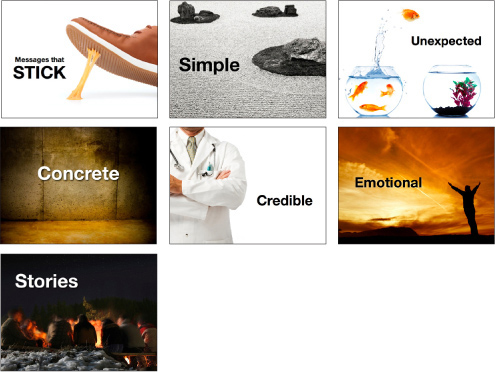Presentation Zen: Simple Ideas on Presentation Design and Delivery, 2nd Edition (Ira Katz's Library) (12 page)
Authors: Garr Reynolds

•
Stories.
We tell stories all day long. It’s how humans have always communicated. We tell stories with our words and even with our art and music. We express ourselves through the stories we share. We teach, we learn, and we grow through stories. In Japan, it is a custom for a senior worker (
sempai
) to mentor a younger worker (
kohai
) on various issues concerning company history and culture and how to do the job. The
sempai
does much of his informal teaching through storytelling although nobody calls it that. Once a younger worker hears the story of what happened to the poor guy who didn’t wear his hardhat on the factory floor, he never forgets the lesson (and he never forgets to wear his hardhat). Stories get our attention and are easier to remember than lists of rules. People love Hollywood, Bollywood, and indie films. People are attracted to “story.” Why is it, though, that when the majority of smart, talented, story-loving people have the chance to present, they usually resort to generating streams of vaguely connected information rather than stories or examples and illustrations? Great ideas and presentations have an element of story to them.

I’ve used these slides in live talks while reviewing the key ideas found in
Made to Stick
by Chip and Dan Heath.
(All images on this page and opposite page from iStockphoto.com.)
I believe this nation should commit itself to achieving the goal, before this decade is out, of landing a man on the Moon and returning him safely to the Earth.
—John F. Kennedy
May 25, 1961

Before there was the written word, humans used stories to transfer culture from one generation to the next. Stories are who we are, and we are our stories. Stories may contain analogies or metaphors, powerful tools for bringing people in and helping them understand our thoughts clearly and concretely. The best presenters illustrate their points with stories, often personal ones. The easiest way to explain complicated ideas is through examples or by sharing a story that underscores the point. If you want your audience to remember your content, then find a way to make it more relevant and memorable by strengthening your core message with good, short, stories or examples.
Good stories have interesting, clear beginnings; provocative, engaging content in the middle; and a clear conclusion. I am not talking about fiction here. I am talking about reality, regardless of the topic. Remember that documentary films, for example, “tell the story” of whatever it is they are reporting on. Documentaries do not simply tell facts; rather, they engage us with the story of war, scientific discovery, a dramatic sea rescue, climate change, and so on. We are wired to forget what our brains perceive as unimportant to our survival. Our conscious mind tells us to read the physical chemistry book over and over because we need to pass the class, but our brain keeps telling us this is dull, uninteresting, and unimportant to our survival. The brain cares about story.
Story is an important way to engage the audience and appeal to people’s need for logic and structure in addition to emotion. Humans are predisposed to remembering experiences in the narrative form; we learn best with a narrative structure. Humans have been sharing information aurally and visually far longer than we have been getting information by reading lists. A 2003
Harvard Business Review
article on the power of story says storytelling is the key to leadership and communication in business: “Forget PowerPoint and statistics, to involve people at the deepest level you need to tell stories.”
In an interview with the
Harvard Business Review
, legendary screenwriting coach Robert McKee suggests a big part of a leader’s job is to motivate people to reach certain goals. “To do that she must engage their emotions,” McKee says, “and the key to their hearts is story.” The most common way to persuade people, says McKee, is with conventional rhetoric and an intellectual process that, in the business world, often consists of a typical PowerPoint presentation in which leaders build their case with statistics and data. But people are not moved by statistics alone, nor do they always trust your data. “Statistics are used to tell lies...while accounting reports are often BS in a ball gown.” McKee says rhetoric is problematic because while we are making our case others are arguing with us in their heads using their own statistics and sources. Even if you do persuade through argument, says McKee, this is not good enough because “people are not inspired to act on reason alone.” The key, then, is to aim to unite an idea with an emotion, which is best done through story. “In a story, you not only weave a lot of information into the telling but you also arouse your listener’s emotion and energy,” he says.
A good story is not the beginning-to-end tale of how results meet expectations, McKee says. This is boring. Instead, it’s better to illustrate the “struggle between expectation and reality in all its nastiness.” What makes life interesting is “the dark side” and the struggle to overcome the negatives—struggling against negative powers is what forces us to live more deeply, says McKee. Overcoming negative powers is interesting, engaging, and memorable. Stories such as this are more convincing.
The biggest element a story has, then, is conflict. Conflict is dramatic. At its core, story is about a conflict between our expectations and cold reality. Story is about an imbalance and opposing forces or a problem that must be worked out. A good storyteller describes what it’s like to deal with these opposing forces such as the difficulty of working with scarce resources, making difficult decisions, or undertaking a long journey of scientific discovery, and so on. People prefer to present only the rosy (and boring) picture. “But as a storyteller, you want to position the problems in the foreground and then show how you’ve overcome them,” says McKee. If you tell the story of how you struggled with antagonists, the audience is engaged with you and your material.
Whether we are talking about graphic design or the components of a story, the principle of contrast is one of the most fundamental and important elements to include. Contrast is about differences, and we are hardwired to notice differences. You can see the principle of contrast everywhere in good storytelling, including filmmaking. For example, in
Star Wars IV
, there is obviously compelling contrast between the good and noble Rebel Alliance and the dark side of the Death Star and the evil empire. Yet great contrasts exist even between main characters in the story who are on the same side. The young, naïve, idealistic Luke Skywalker character contrasts with the old, wise, and realistic Obi-Wan Kenobi. The level-headed, diplomatic, young Princess Leia contrasts with the slightly cocky, irreverant, older Han Solo. These characters are compelling to millions of fans because of their inherent contrasts and the series of negotiations they go through as they deal with their differences. Even R2D2 and C3PO are engaging characters, in large part because of their strikingly different personalities. In your own presentations, look for contrasts such as before/after, past/future, now/then, problem/solution, strife/peace, growth/decline, pessimism/optimism, and so on. Highlighting contrasts is a natural way to bring the audience into your story and make your message more memorable.
You do not always have a lot of time to prepare your presentation or perhaps it is difficult to see what the story is, so here are three simple steps you can use to prepare virtually any presentation relatively quickly.
Basic elements to include in your story:
1.
Identify the problem.
(This could be a problem, for example, that your product solves.)
2.
Identify causes of the problem.
(Give actual examples of the conflict surrounding the problem.)
3.
Show how and why you solved the problem.
(This is where you provide resolution to the conflict.)
Essentially, that’s it: Introduce the problem you have (or did have) and how you will solve it (or did solve it). Give examples that are meaningful and relevant to your audience. Remember, story is sequential: “This happened, and then this happened, and therefore this happened, and so on.” Take people on a journey that introduces conflict and then resolves that conflict. If you can do this, you will be miles ahead of most presenters who simply recall talking points and broadcast lists of information. Audiences tend to forget lists and bullet points, but stories come naturally to us; it’s how we’ve always attempted to understand and remember the bits and pieces of experience. Robert McKee’s point is that you should not fight your natural inclination to frame experiences into a story; instead, embrace this and tell the story of your experience of the topic to your audience.
Our brains tend to recall experiences or stories that have a strong emotional element to them. The emotional components of stories are what helps them be remembered. Earlier this year, four students in my Japanese labor management class did a presentation on employment security in Japan. Three days later, when I asked other students to recall the most salient points of the presentation, what they remembered most vividly were not the labor laws, the principles, and the changes in the labor market in Japan but, rather, the topic of
karoshi
, or suicide related to work, and the issue of suicides in Japan, topics that were quite minor points in the hour-long presentation. Perhaps five minutes out of the hour were spent on the issue of karoshi, but that’s what the audience remembered most. It’s easy to understand why. The issue of death from overworking and the relatively high number of suicides are extremely emotional topics that are not often discussed. The presenters cited actual cases and told stories of people who died as a result of karoshi. The stories and the connections they made with the audience caused these relatively small points to be remembered because emotions such as surprise, sympathy, and empathy were all triggered.
Kamishibai: Lessons in Visual Storytelling from Japan
Kamishibai
is a form of visual and participatory storytelling that combines the use of hand-drawn visuals with the engaging narration of a live presenter.
Kami
( ) means “paper” and
) means “paper” and
shibai
( ) means “play/drama.” The origins of kamishibai can be traced back to various picture storytelling traditions in Japan, which include
) means “play/drama.” The origins of kamishibai can be traced back to various picture storytelling traditions in Japan, which include
etoki
and
emaki
scrolls and other forms of visual storytelling dating back centuries. However, the form of kamishibai that one thinks of today developed around 1929 and was popular in the 1930s, and ’40s, all but dying out with the introduction of television later in the 1950s. Typical kamishibai consisted of a presenter who stood to the right of a small wooden box or stage that held the 12–20 cards featuring the visuals that accompanied each story. This miniature stage was attached to the storyteller’s bicycle, from which he sold candy to the small children who gathered before the show (this was originally how the storyteller could make a little money). The presenter changed the cards by hand, varying the speed of the transition to match the flow of the story he was telling. The best kamishibai presenters did not read the story, but instead kept their eyes on the audience and occasionally on the current card in the frame.

Kamishibai is as different from picture books as modern presentation visuals are different from documents. In the case of a picture book, there can be more visual details and text. However, picture books are usually read alone unlike kamishibai which is designed to be presented in front of a larger group gathered around the presenter and his visuals.
Although kamishibai is a form of visual storytelling that became popular more than eighty years ago, the lessons from this craft can be applied to modern multimedia presentations. Tara McGowan, who wrote
The Kamishibai Classroom
(Libraries Unlimited), says that kamishibai visuals are more like the frames in a movie. “Kamishibai pictures are designed to be seen only for a few [moments], so extraneous details detract from the story and open up the possibilities of misinterpretation.
”
It’s important to design each card, she says, “...to focus the audience’s attention on characters and scenery that are most important at any given moment. If clarity and economy of expression are the goals, it would be hard to find a more perfect medium.
”
It’s easy to imagine how we can apply the same spirit of kamishibai to our modern-day presentations that include the use of multimedia and a screen. Here are five tips from kamishibai that we can apply to our presentations today:
1.
Visuals should be big, bold, clear, and easy to see.
2.
Allow graphic elements to fill the frame and bleed off the edges.
3.
Use visuals in an active way, not a decorative one.
4.
Aim to carefully trim back the details.
5.
Make your presentation—visuals and narration—participatory.